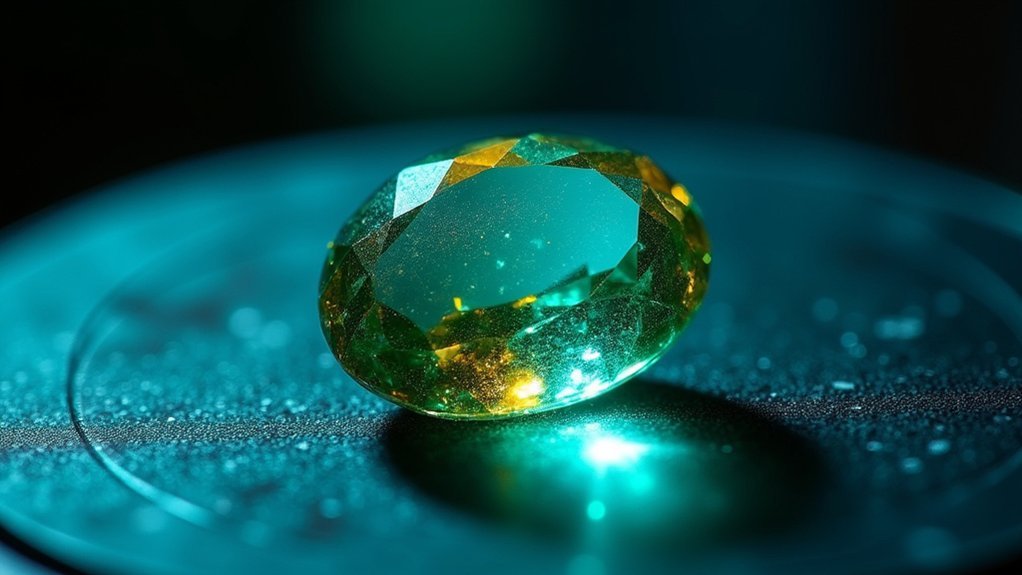Polariscope tests use polarized light to identify critical gemstone properties by examining how light passes through crystals. You’ll place your gem between crossed polarizing filters and rotate it to distinguish between isotropic gems (remain dark) and anisotropic gems (show alternating light/dark patterns). This analysis reveals crystal structure, strain patterns, twinning, and can help detect synthetic or treated stones. Understanding these optical behaviors gives you powerful insights for accurate gemstone identification and authentication.
Understanding the Science of Polarized Light in Gemology

When examining gemstones with precision, you’ll find that polarized light serves as an essential diagnostic tool in modern gemology. A polariscope reveals critical optical properties by manipulating light waves that pass through crystalline structures.
You can distinguish between singly refractive gems (which remain dark under crossed polarizers) and doubly refractive materials (which display alternating light and dark areas during rotation). This fundamental difference in light behavior forms the basis of accurate gem identification.
The polariscope also helps you detect anomalous double refraction, where gemstones exhibit unexpected optical responses that reveal their true nature.
Essential Components and Setup of a Polariscope
You’ll need to choose between linear and circular polarizing filters when setting up your polariscope, with linear filters being more straightforward for basic gemstone testing.
If you’re building a DIY polariscope, secure two polarizing sheets approximately 3-4 inches apart, with one fixed and one that can rotate freely for analysis.
Mount your filters on a stable platform with a light source beneath, ensuring they’re properly aligned in a crossed position before introducing any gemstone specimens.
Polarizer Filter Configurations
At the heart of every polariscope lies its vital filter configuration, which determines the instrument’s effectiveness in gemstone analysis. The polariscope combines a stationary polarizer filter at the bottom with a rotating analyzer at the top to reveal optical properties as light waves pass through your specimen.
For ideal results when examining refractive properties:
- Position the polarizer and analyzer in a crossed position (perpendicular to each other) to create the necessary dark field background.
- Choose linear polarizers for your setup, as they’re more user-friendly than circular options for standard gemstone analysis.
- Consider adding specialized lighting beneath the polarizer filter to enhance contrast and visibility of internal features.
When properly configured, you’ll observe distinctive light and dark patterns that reveal essential information about your gemstone’s structure.
DIY Polariscope Assembly
Building your own polariscope at home offers an accessible entry point into gemstone testing without investing in expensive professional equipment. The essential components include a light source, a fixed polarizer, and a rotating polarizer (analyzer component) that work together to reveal optical properties of gemstones.
You can use any light source—flashlights or desk lamps work well, and adding mirrors can enhance light direction and intensity. For polarizing filters, repurpose old sunglasses or invest in photography-grade polarizers for better clarity in gem analysis. High-quality filters will provide more accurate results when examining birefringence and other optical characteristics.
Assembling your DIY polariscope not only saves money but also deepens your understanding of how light interacts with gemstones, making you more proficient at gemstone testing over time.
Distinguishing Isotropic vs. Anisotropic Gemstones

When you place a gemstone in a polariscope, you’ll immediately note fundamental differences in optical properties between isotropic and anisotropic specimens.
You can identify strain patterns in seemingly isotropic stones like diamonds, which may display anomalous double refraction due to internal stress.
Light interference effects create distinctive dark and light flashes as you rotate anisotropic gems through a full 360 degrees, providing clear visual confirmation of their crystalline structure.
Optical Properties Fundamentals
The fundamental distinction between isotropic and anisotropic gemstones lies at the heart of polariscope testing.
When you examine a gemstone with a polariscope, you’re analyzing how light interacts with its internal structure. Isotropic gems like diamond and garnet maintain consistent optical properties regardless of direction, while anisotropic stones like quartz show directional variations in their refraction patterns.
As a gemologist, you’ll notice these key differences during analysis:
- Consistent brightness – Isotropic gems maintain uniform appearance when rotated.
- Double refraction – Anisotropic gems split light into two rays, creating distinctive patterns.
- Angular shifts – ADR gemstones show light-to-dark variations at 90° intervals.
Understanding these optical properties helps you accurately identify gemstones, especially when dealing with lookalikes that share similar visual characteristics.
Strain Pattern Analysis
Strain patterns revealed through polariscope testing offer definitive evidence for classifying gemstones as either isotropic or anisotropic.
When you place a specimen between crossed polarizers, isotropic gemstones like diamond and garnet remain dark throughout rotation, showing no double refraction. In contrast, anisotropic materials such as quartz and tourmaline display distinctive light and dark bands as you rotate them.
Your thorough analysis should include systematic rotation of the gemstone to observe how light behavior changes in the polarized light field. This reveals internal tensions and inclusions that inform you about the stone’s formation.
Watch carefully for anomalous double refraction (ADR), where certain stones exhibit unexpected optical properties. These strain pattern analysis techniques provide essential data for accurate gemstone classification, allowing you to distinguish genuine specimens from imitations based on their fundamental optical characteristics.
Light Interference Effects
Understanding light interference effects within the polariscope creates a fundamental basis for distinguishing between isotropic and anisotropic gemstones.
When you conduct polariscope testing, you’ll observe how light behaves differently through various crystal structures, revealing essential optical properties.
During examination, you’ll notice:
- Isotropic gemstones (like diamond and garnet) remain consistently dark through a complete rotation, as they don’t exhibit double refraction.
- Anisotropic gemstones (such as quartz and tourmaline) display alternating light and dark patterns during rotation due to their double-refractive nature.
- Anomalous double refraction appears as unexpected light behaviors in certain stones, challenging standard classification.
These distinctive light interference patterns help gemologists accurately identify and classify gemstones based on their fundamental crystalline structures, providing definitive evidence of their internal composition.
Detecting Crystal Strain, Twinning, and Anomalous Effects

When examining gemstones under polarized light, you’ll discover revealing patterns that expose their internal structure and potential flaws. Your polariscope can identify crystal strain through distinctive light patterns, revealing internal tension that may compromise a stone’s durability and appearance.
You’ll notice twinning appears as parallel color layers or unusual refraction patterns when rotating the gem. These optical characteristics are essential for accurate gem identification.
When a stone exhibits changes in light intensity at all 90° angles, you’re observing anomalous double refraction (ADR), indicating unique structural formation.
These features greatly impact clarity and gem appraisal value. They’re also powerful indicators when authenticating natural versus synthetic stones, as manufactured gems typically lack these natural characteristics.
Mastering polariscope analysis helps you make more informed decisions about gemstone quality and authenticity.
Advanced Testing Techniques for Challenging Specimens
Although standard polariscope methods work well for common gemstones, you’ll need specialized techniques for specimens that present ambiguous results.
Advanced testing techniques in polariscope analysis can reveal essential optical properties like anomalous double refraction (ADR), which often indicates synthetic gemstones or treatments.
When you encounter complex materials, try these enhanced approaches:
- Utilize crossed polarizers and rotate the specimen a full 360 degrees to detect subtle internal stress, twinning patterns, and inclusions that standard testing might miss.
- Add a tint plate to clarify optical characteristics when results appear ambiguous, helping confirm the gemstone type.
- Implement specialized lighting and filter upgrades for examining heavily included or multi-layered specimens that show atypical reactions under polarized light.
Interpreting Results: What Your Observations Reveal About Gemstones

With advanced testing techniques mastered, the next challenge is making sense of what you observe.
During polariscope testing, your gemstone’s light behavior tells a critical story. If it remains uniformly dark throughout a 360-degree rotation, you’re dealing with an isotropic (singly refractive) specimen. Alternating light and dark patterns indicate an anisotropic (doubly refractive) gemstone.
Watch for anomalous double refraction (ADR), which appears as consistent light-dark changes at each 90-degree interval.
During confirmation tests, if your gem brightens when rotating the analyzer from dark to light positions, it’s singly refractive or amorphous. If it maintains its darkness or darkens further, it’s doubly refractive.
These observations reveal more than just refractive properties—they offer insights into the gemstone’s internal structure, including twinning patterns and internal strain.
Frequently Asked Questions
What Is the Best Tool to Test Gemstones?
The polariscope is your best tool for testing gemstones. You’ll use it to analyze a gem’s refractive properties through polarized light, helping you distinguish between isotropic and anisotropic materials with precision.
What Is a Polariscope in Gemology?
A polariscope is a tool you’ll use in gemology to identify if gems are isotropic or anisotropic. It’s made of two polarizing filters that help you analyze how light interacts with stones during rotation.
How to Use Gem Polariscope?
To use a gem polariscope, you’ll need to cross the polarizer and analyzer first. Place your clean gemstone on the stage, rotate it 360 degrees, and observe its light response to determine its refractive properties.
What Is XRF for Gemstone?
XRF is a non-destructive testing method you’ll use to identify a gemstone’s elemental composition. It’ll detect trace elements by measuring X-rays emitted when your stone is exposed to an X-ray source.
In Summary
Polariscope testing gives you powerful insights into a gemstone’s optical character that aren’t visible to the naked eye. You’ll quickly determine if stones are singly or doubly refractive, identify synthetic materials, and detect internal strain. By mastering this essential gemological tool, you’re equipped to authenticate specimens with greater confidence and understand the crystalline structure that makes each gemstone unique.





Leave a Reply